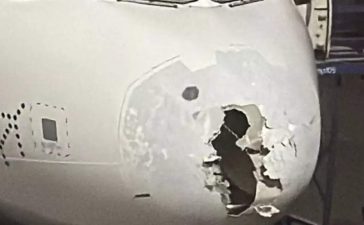Deteriorating air quality is a major threat to health, and scientists have discovered that humans are not the only ones in danger.
Grey squirrels suffer worsening lung damage the closer they live to the centre of a city, according to a study in London. It found the lungs of the rodent residents of Richmond fare far better than those of central Westminster.
The research – published last week in the journal Environmental Pollution – highlights the extent of air contamination in cities and suggests that many other species, including wild animals and birds as well as pet cats and dogs, could be affected by particles in the air from traffic and other sources.
“In recent years, there have been sharp drops in populations of species that had previously adapted quite well to city life,” said researcher Patricia Brekke of the Zoological Society London. “These have included butterflies, bees, sparrows, starlings and hedgehogs. All have suffered massive recent losses of numbers.”
One possible explanation has been the effect of air pollution, although there has been a lack of direct evidence to support the idea in wild mammals. The squirrel research aimed to fill that gap.
The grey squirrel (Sciurus carolinensis) – which is native to North America – was introduced to Britain in the late 1800s and has since spread over most of England and Wales at the expense of the native red squirrel (Sciurus vulgaris).
Apart from being bigger, grey squirrels often carry the squirrelpox virus which rarely affects them but often kills red squirrels. As a result, the grey is now considered to be a pest and culls are carried out regularly. Researchers used these animals as the subjects for their research.
The team studied 106 culled animals from five London boroughs – Camden, Greenwich, Haringey, Richmond upon Thames and Westminster – as well as two rural sites at Alice Holt, Surrey and Penrhyn Castle, north Wales. The squirrels were examined for symptoms of lung disease; for the presence of black carbon particles in their lung tissue; and for the signs of damage to lymph node tissue that is known as bronchus-associated lymphoid tissue.
“We found that squirrels who had come from the inner city had a lot more black carbon in their lung tissue but less lymphoid tissue in their lungs compared with those that had been culled from outer regions of London,” said Simon Priestnall, of the Royal Veterinary College, London.
“In short, the lungs of those squirrels that were culled in Westminster in central London were much worse off than those that came from the city’s outskirts, like leafy Richmond. And of course, air pollution is at its worst in the heart of a city as opposed to its outskirts.”
A main cause of this tainting of the air occurs in the city when microscopic particulates are pumped into the atmosphere from construction work and traffic. Sources include diesel fumes as well as particulates from tyres and brake linings. This makes humans highly vulnerable to its impact. It was estimated in one recent research study that air pollution contributed to around 6,000 excess deaths in London in 2019.
It is also known that neurodegenerative diseases have higher rates among people who live in city centres compared with those who live elsewhere,” added Brekke. “The question is: are other species affected this way?”
after newsletter promotion

The researchers are now looking to follow up their lung research with studies that will examine the brains of squirrels to determine if their cognition or behaviour might be affected by air pollution.
The team also wants to look at pets, dogs in particular.
“When you take your dog for a daily walk, it is sharing your breathing space,” Priestnall told the Observer. “And you live in the same house and travel in the same car where both humans and pets are exposed to the same high concentrations of air pollution and that is something else we would like to study.
“Are dogs affected in the same way as humans?
“The crucial point is that animals – particularly squirrels – have something to tell us. They are giving us another warning about the dangers of air pollution,” said Brekke. “They are not so much the canary in the coal mine as the rodent in the undergrowth.”









